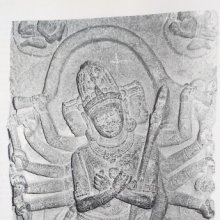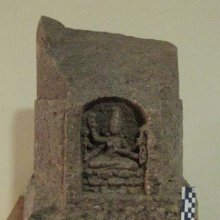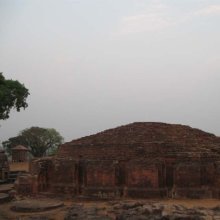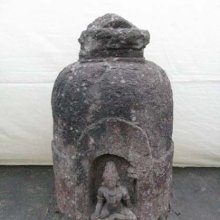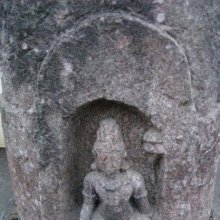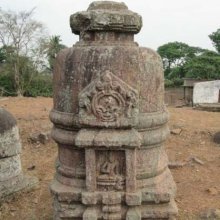Ratnagiri, Ratna-giri: 4 definitions
Introduction:
Ratnagiri means something in Hinduism, Sanskrit, the history of ancient India. If you want to know the exact meaning, history, etymology or English translation of this term then check out the descriptions on this page. Add your comment or reference to a book if you want to contribute to this summary article.
Images (photo gallery)
(+254 more images available)
In Hinduism
Ayurveda (science of life)
Rasashastra (Alchemy and Herbo-Mineral preparations)
Source: Wisdom Library: Rasa-śāstraRatnagiri (रत्नगिरि) is the name of an Ayurvedic recipe defined in the fourth volume of the Rasajalanidhi (chapter 2, dealing with jvara: fever). These remedies are classified as Iatrochemistry and form part of the ancient Indian science known as Rasaśāstra (medical alchemy). However, as an ayurveda treatment, it should be taken twith caution and in accordance with rules laid down in the texts.
Accordingly, when using such recipes (e.g., ratna-giri-rasa): “the minerals (uparasa), poisons (viṣa), and other drugs (except herbs), referred to as ingredients of medicines, are to be duly purified and incinerated, as the case may be, in accordance with the processes laid out in the texts.” (see introduction to Iatro chemical medicines)

Āyurveda (आयुर्वेद, ayurveda) is a branch of Indian science dealing with medicine, herbalism, taxology, anatomy, surgery, alchemy and related topics. Traditional practice of Āyurveda in ancient India dates back to at least the first millenium BC. Literature is commonly written in Sanskrit using various poetic metres.
India history and geography
Source: Marathi language (Marāṭhī bhāṣā): Submission for Classical Status of Marathi LanguageRatnagiri is the name of a district in Maharashtra.—The Buddhist work, Mahavamsa, refers to Maharashtra. It suggests that a big area around Ujjain, that is, the present Central India could have been talked about as Maharashtra. As the legend goes there were (or might have been) 99,000 villages in this country. These days it is a practice to include all areas (Ratnagiri) where Marathi language is in use into Maharashtra.

The history of India traces the identification of countries, villages, towns and other regions of India, as well as mythology, zoology, royal dynasties, rulers, tribes, local festivities and traditions and regional languages. Ancient India enjoyed religious freedom and encourages the path of Dharma, a concept common to Buddhism, Hinduism, and Jainism.
Languages of India and abroad
Sanskrit dictionary
Source: Cologne Digital Sanskrit Dictionaries: Monier-Williams Sanskrit-English DictionaryRatnagiri (रत्नगिरि):—[=ratna-giri] [from ratna] m. Name of a mountain, [Buddhist literature]
[Sanskrit to German]
Sanskrit, also spelled संस्कृतम् (saṃskṛtam), is an ancient language of India commonly seen as the grandmother of the Indo-European language family (even English!). Closely allied with Prakrit and Pali, Sanskrit is more exhaustive in both grammar and terms and has the most extensive collection of literature in the world, greatly surpassing its sister-languages Greek and Latin.
See also (Relevant definitions)
Starts with: Ratnagirirasa, Ratnagirivatageya.
Query error!
Full-text (+13): Ratnagirirasa, Babhravya, Shriratnagiri, Ratnagirivatageya, Sanilani, Shandilya, Hatavinda, Tanara, Koritaka, Gaditambaku, Jhalana, Guma, Vaidyanatha shastrin, Tetavinem, Dandevinda, Ghumau, Vatsa, Buricem Jalem, Bharadvaja, Gamvakara.
Relevant text
Search found 25 books and stories containing Ratnagiri, Ratna-giri; (plurals include: Ratnagiris, giris). You can also click to the full overview containing English textual excerpts. Below are direct links for the most relevant articles:
World Journal of Pharmaceutical Research
Successful extraction of pigments from bacteria in soil samples < [2018: Volume 7, May issue 9]
Comparative study of proximate composition of Epiphyllum oxypetalum. < [2016: Volume 5, March issue 3]
Production of bioethanol from lxora coccinea < [2016: Volume 5, June issue 6]
Stupas in Orissa (Study) (by Meenakshi Chauley)
Kalachakrayana (in Tantric Buddhism) < [Chapter 2]
Bronze Stupas at Ratnagiri < [Chapter 4]
On the use of Human remains in Tibetan ritual objects (by Ayesha Fuentes)
Charnel materials in the Saṃvara tradition < [Chapter 2 - The use of skulls and bone ornaments]
Bone ornaments (Rügyen or “rus rgyan”) and Tantric practice < [Chapter 4 - Human remains in Tibetan ritual objects: A technical study]
Temples of Purushottama Kshetra Puri (by Ratnakar Mohapatra)
5.7. Buddhist Images in Odisha art < [Chapter 2 - Characteristics features of Orissan Temples]
5.11. Parsva Devatas in Odisha art < [Chapter 2 - Characteristics features of Orissan Temples]
8. Review of Literatures < [Chapter 1 - Introduction]
Studies in Indian Literary History (by P. K. God)
34. Visvanatha Mahadeva Ranade < [Volume 2 (1954)]
13. The Vedabhasyasara of Bhattoji Diksita < [Volume 2 (1954)]
32. Vidyavilasa, a commentary on the Siddhanta-Kaumudi < [Volume 2 (1954)]
Notices of Sanskrit Manuscripts (by Rajendralala Mitra)
Page 211 < [Volume 14 (1904)]
